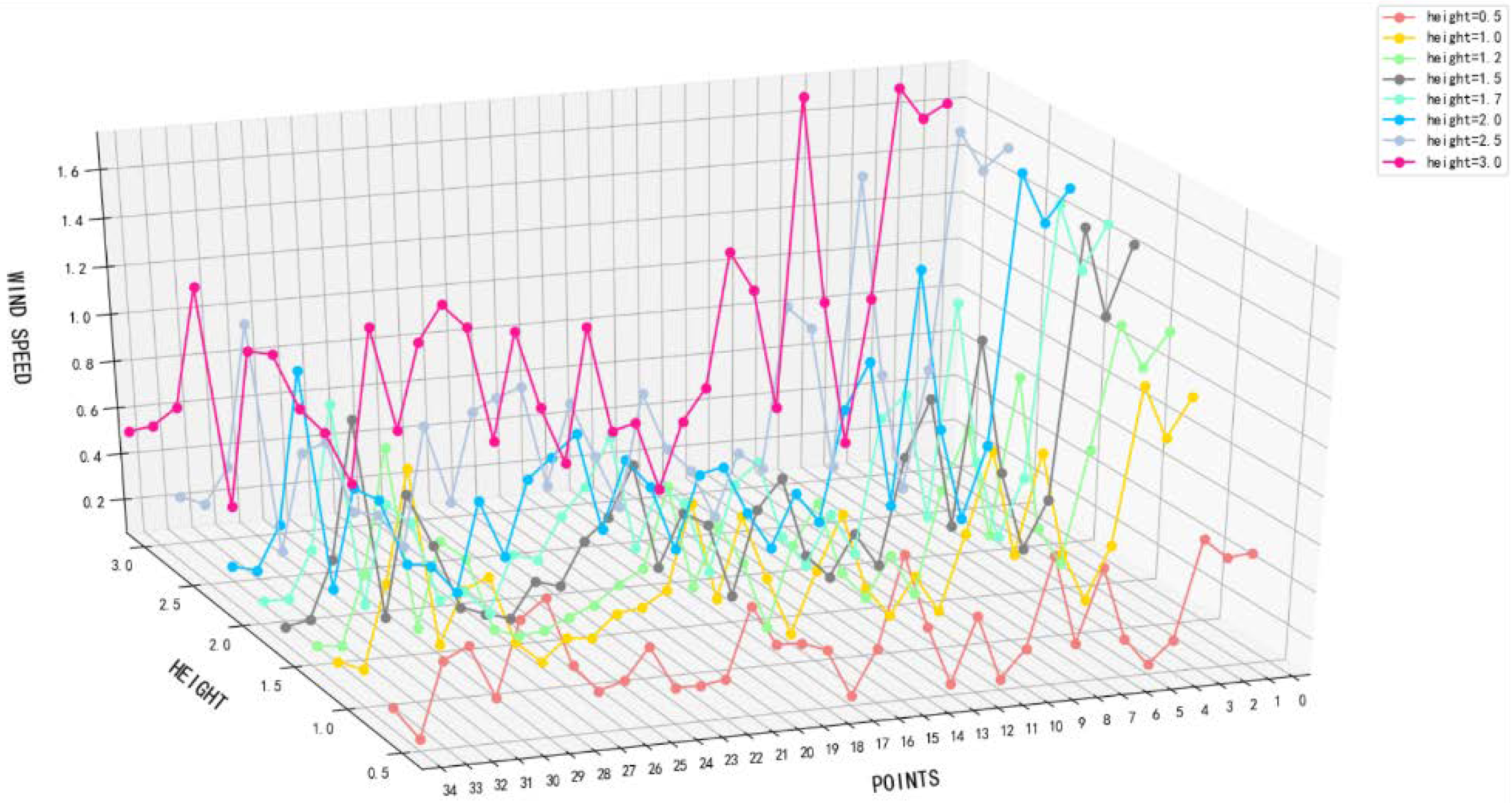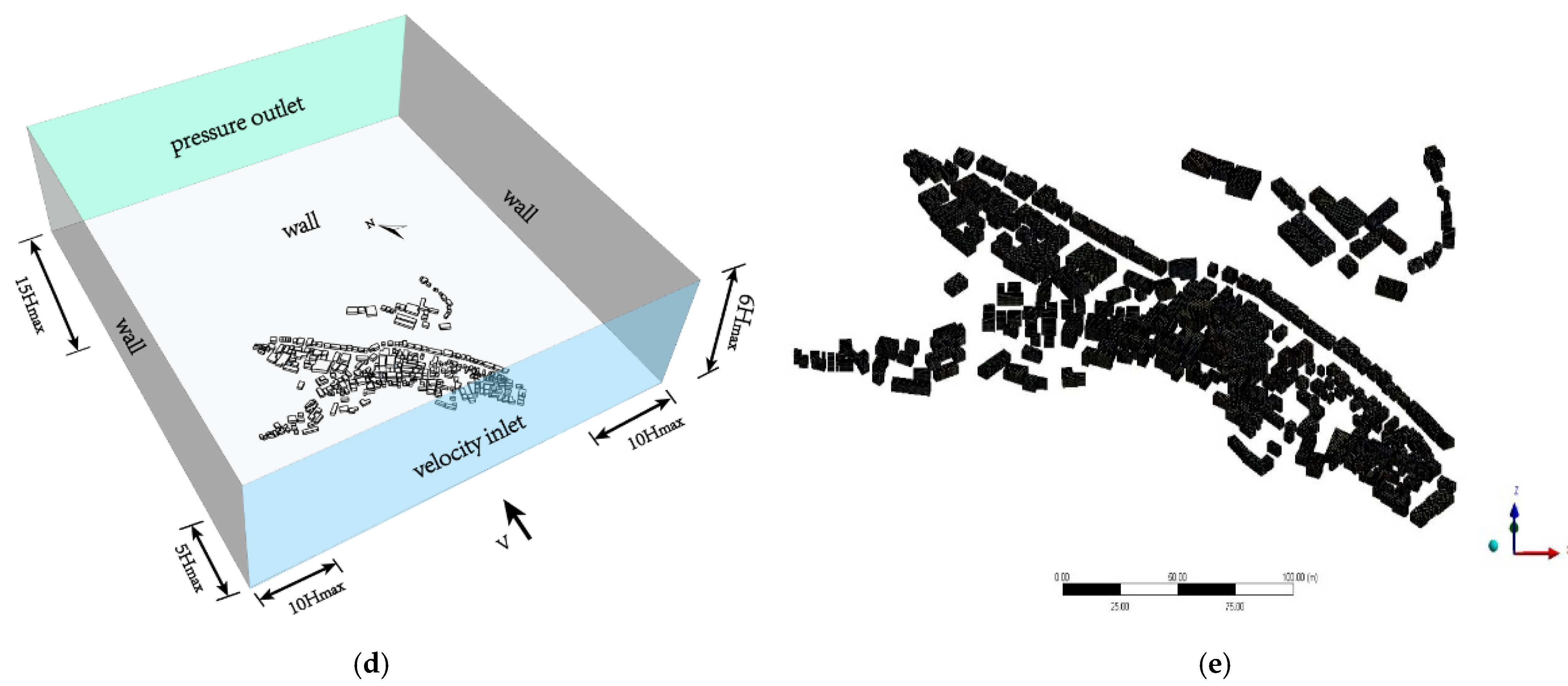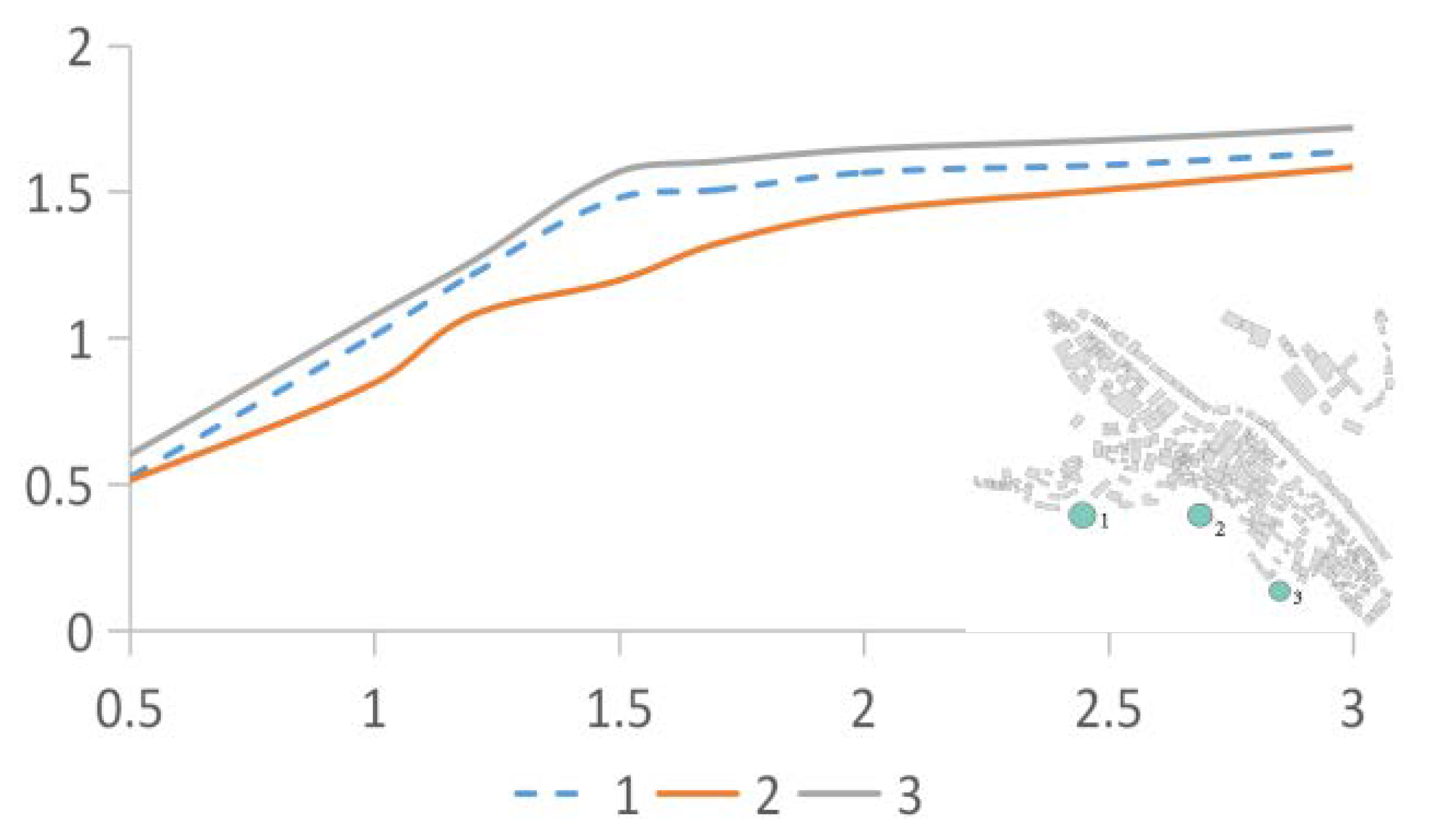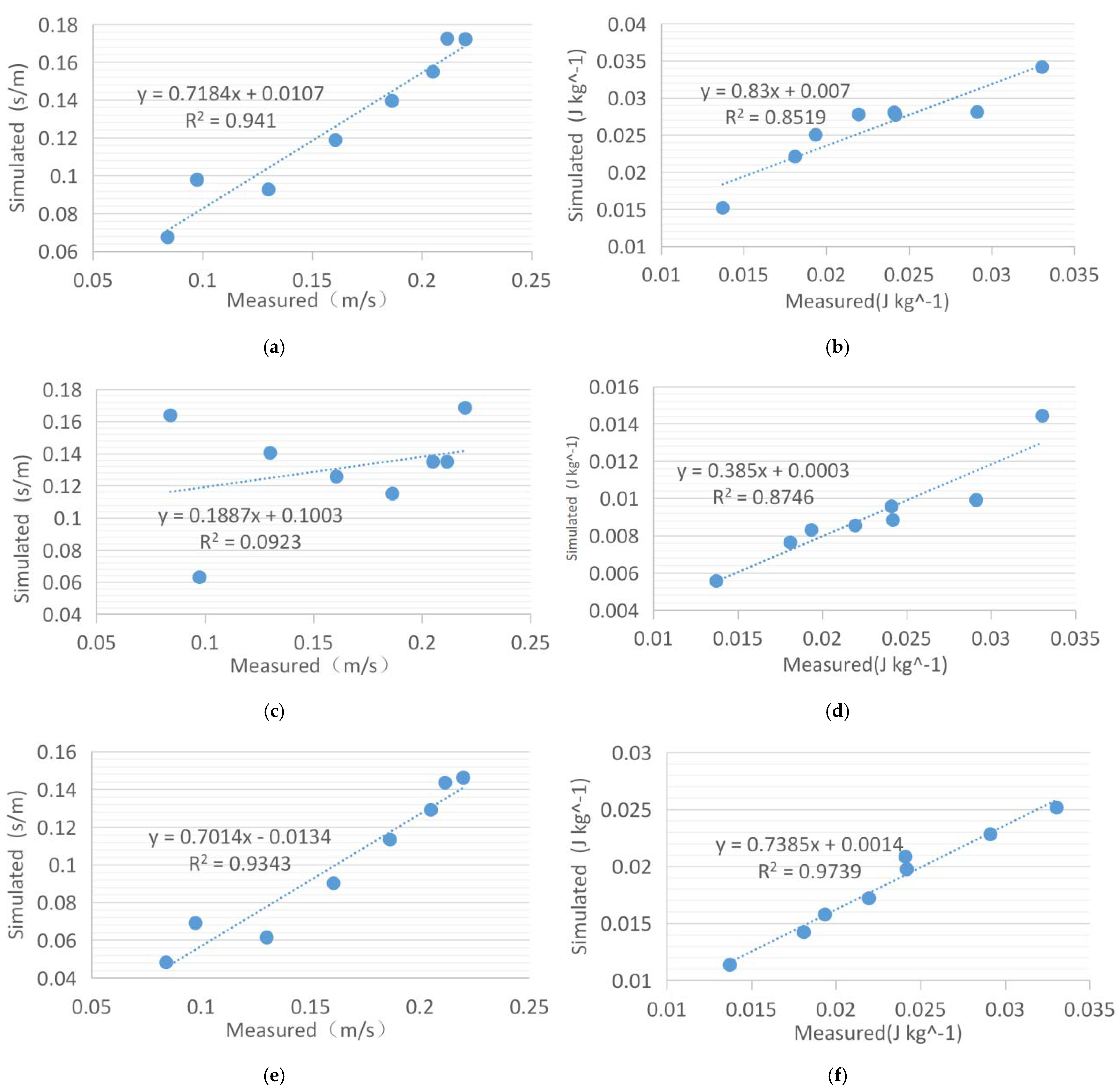Wind Environment Simulation Accuracy in Traditional Villages with Complex Layouts Based on CFD
Abstract
:1. Introduction
1.1. Motivation
1.2. Previous Studies
1.3. Scientific Originality
1.4. Target of This Study
- Using wind speed, direction, and turbulence intensity as reference factors, discussing the deviation in the results of the three steady-state solvers (SKE, RNG, and RKE), and finding the simulation solver with the smallest deviation;
- Analyzing the causes of deviation in the solver in terms of overall, local, and vertical directions;
- Choosing the most suitable solver for the simulation of complex rural settlement wind environments.
2. Methodology
- Field survey: Different types of villages were collected and sorted, and representative villages relevant to the research were selected;
- Data measurement: The relevant data of these villages were measured, including village scope, building distribution, street size, wind speed, wind direction, turbulence intensity value, etc.;
- Summarize and organize the data: After the measured data were unified and integrated, the most representative data were used as the study case;
- Simulation analysis: A model was established based on the measured data, and three steady-state solvers were selected to separately simulate the wind environment of the buildings;
- Comparison of simulated and measured data: The simulated data were compared with the measured data, the deviation of the three solvers was calculated, and the causes of the deviation were analyzed;
- Conclusions: The most suitable solver for simulating the wind environment of complex rural settlements was found.
2.1. Investigation
2.2. Data Measurement and Model Setting
2.3. Setting and Verification of the Air Inlet Wind Speed
3. Results and Discussion
3.1. Comparison of Measured Data and Simulated Data inside the Village
3.2. Reasons for RNG Deviation
3.3. Comparison of Wind Environment Distribution in the Overall Village
3.3.1. Horizontal Contrast
3.3.2. Vertical Contrast
3.3.3. Comprehensive Reliability Analysis of Actual Measurement and Simulation
3.4. Perspectives and Prospects
- More villages need to be selected and classified according to the characteristics of building layout, climate division, topographical conditions, number of buildings, and street size.
- Summarize the characteristics of villages presented by different classifications, use three solvers to calculate the same type of villages, and find out the relationship between similar villages and solvers.
- Summarize the calculation results and find the most suitable steady-state solver corresponding to different types of villages.
4. Conclusions
- In the simulation of the village wind environment with a complex building layout, among the three steady-state solvers of FLUENT, the wind speed and turbulence intensity values obtained by the SKE solver have the highest reliability, and the degrees of fit are 0.8625 and 0.9088 respectively. The reliability of the RNG simulation is the lowest: the fit of the wind speed distribution is 0.7881, and the fit of the turbulence intensity is only 0.2473. Therefore, for villages with complex building layouts, the SKE solver should be the first choice when simulating wind speed distribution and turbulence intensity distribution.
- When using the RNG solver, the overall obtained turbulence intensity value is higher than the measured value. The simulated value at a height of 1.7 m differs from SKE and RKE by 42.61%. The main reason for this is that RNG over-represents the vortex and underestimates the airflow rate in the building interval.
- In the vertical direction, RNG cannot capture the complex wind flow structures that appear in the wake of high-rise buildings and narrow-span streets in complex building areas well, which leads to an overestimation of turbulence intensity values in these locations.
Author Contributions
Funding
Institutional Review Board Statement
Informed Consent Statement
Data Availability Statement
Acknowledgments
Conflicts of Interest
References
- United Nations. World urbanization prospects: The 2014 revision, highlights Department of Economic and Social Affairs. Popul. Div. U. N. 2014, 32, 24–25. [Google Scholar]
- Pomázi, I. OECD Environmental Outlook to 2050: The Consequences of Inaction. Hung. Geogr. Bull. 2012, 61, 343–345. [Google Scholar]
- World Health Organization, WHO Library Cataloguing-in-Publishtion Data. WHO Ambient Air Pollution: A Global Assessment of Exposure and Burden of Disease; WHO: Geneva, Switzerland, 2016. [Google Scholar]
- Neophytou, M.K.-A.; Britter, R.E. Modelling of atmospheric dispersion in complex urban topographies: A computational fluid dynamics study of the central London area. In Proceedings of the GRACM 05: 5th GRACM International Congress on Computational Mechanics, Limassol, Cyprus, 29 June–1 July 2005; Volume 2, pp. 967–974. [Google Scholar]
- Panagiotou, I.; Neophytou, M.K.A.; Hamlyn, D.; Britter, R.E. City breathability as quantified by the exchange velocity and its spatial variation in real inhomogeneous urban geometries: An example from central London urban area. Sci. Total Environ. 2013, 442, 466–477. [Google Scholar] [CrossRef]
- Buccolieri, R.; Sandberg, M.; Di Sabatino, S. City breathability and its link to pollutant concentration distribution within urban-like geometries. Atmos. Environ. 2010, 44, 1894–1903. [Google Scholar] [CrossRef]
- Hang, J.; Li, Y. Ventilation strategy and air change rates in idealized high-rise compact urban areas. Build. Environ. 2010, 45, 2754–2767. [Google Scholar] [CrossRef]
- Liu, C.; Leung, D.Y.C.; Barth, M.C. On the prediction of air and pollutant exchange rates in street canyons of different aspect ratios using large-Eddy simulation. Atmos. Environ. 2005, 39, 1567–1574. [Google Scholar] [CrossRef]
- Kubilay, A.; Neophytou, M.K.; Matsentides, S.; Loizou, M.; Carmeliet, J. Urban Climate the pollutant removal capacity of urban street canyons as quantified by the pollutant exchange velocity. Urban Clim. 2017, 21, 136–153. [Google Scholar] [CrossRef]
- Antoniou, N.; Montazeri, H.; Wigo, H.; Neophytou, M.K.A.; Blocken, B.; Sandberg, M. CFD and wind-tunnel analysis of outdoor ventilation in a real compact heterogeneous urban area: Evaluation using “air delay”. Build. Environ. 2017, 126, 355–372. [Google Scholar] [CrossRef]
- Tominaga, Y.; Stathopoulos, T. CFD modeling of pollution dispersion in a street canyon: Comparison between LES and RANS. J. Wind Eng. Ind. Aerodyn. 2011, 99, 340–348. [Google Scholar] [CrossRef] [Green Version]
- Stathopoulos, T. Pedestrian level winds and outdoor human comfort. J. Wind Eng. Ind. Aerodyn. 2006, 94, 769–780. [Google Scholar] [CrossRef]
- Toparlar, Y.; Blocken, B.; Vos, P.; van Heijst, G.J.F.; Janssen, W.D.; van Hooff, T.; Montazeri, H.; Timmermans, H.J.P. CFD simulation and validation of urban microclimate: A case study for Bergpolder Zuid, Rotterdam. Build. Environ. 2015, 83, 79–90. [Google Scholar] [CrossRef] [Green Version]
- Montazeri, H.; Blocken, B. New generalized expressions for forced convective heat transfer coefficients at building facades and roofs. Build. Environ. 2017, 119, 153–168. [Google Scholar] [CrossRef] [Green Version]
- Juan, Y.H.; Yang, A.S.; Wen, C.Y.; Lee, Y.T.; Wang, P.C. Optimization procedures for enhancement of city breathability using arcade design in a realistic high-rise urban area. Build. Environ. 2017, 121, 247–261. [Google Scholar] [CrossRef]
- Gousseau, P.; Blocken, B.; Stathopoulos, T.; Van Heijst, G.J.F. CFD simulation of near-field pollutant dispersion on a high-resolution grid: A case study by LES and RANS for a building group in downtown Montreal. Atmos. Environ. 2011, 45, 428–438. [Google Scholar] [CrossRef] [Green Version]
- Jing, Y.; Zhong, H.Y.; Wang, W.W.; He, Y.; Zhao, F.Y.; Li, Y. Quantitative city ventilation evaluation for urban canopy under heat island circulation without geostrophic winds: Multi-scale CFD model and parametric investigations. Build. Environ. 2021, 196, 107793. [Google Scholar] [CrossRef]
- Ding, C.; Lam, K.P. Data-driven model for cross ventilation potential in high-density cities based on coupled CFD simulation and machine learning. Build. Environ. 2019, 165, 106394. [Google Scholar] [CrossRef] [Green Version]
- Luo, Z.; Li, Y. Passive urban ventilation by combined buoyancy-driven slope flow and wall flow: Parametric CFD studies on idealized city models. Atmos. Environ. 2011, 45, 5946–5956. [Google Scholar] [CrossRef]
- Zeng, L.; Liu, G.; Gao, J.; Du, B.; Lv, L.; Cao, C.; Ye, W.; Tong, L.; Wang, Y. A circulating ventilation system to concentrate pollutants and reduce exhaust volumes: Case studies with experiments and numerical simulation for the rubber refining process. J. Build. Eng. 2021, 35, 101984. [Google Scholar] [CrossRef]
- Lauriks, T.; Longo, R.; Baetens, D.; Derudi, M.; Parente, A.; Bellemans, A.; van Beeck, J.; Denys, S. Application of Improved CFD Modeling for Prediction and Mitigation of Traffic-Related Air Pollution Hotspots in a Realistic Urban Street. Atmos. Environ. 2021, 246, 118127. [Google Scholar] [CrossRef]
- Keshavarzian, E.; Jin, R.; Dong, K.; Kwok, K.C. Effect of building cross-section shape on air pollutant dispersion around buildings. Build. Environ. 2021, 197, 107861. [Google Scholar] [CrossRef]
- Jiang, Z.; Cheng, H.; Zhang, P.; Kang, T. Influence of urban morphological parameters on the distribution and diffusion of air pollutants: A case study in China. J. Environ. Sci. 2021, 105, 163–172. [Google Scholar] [CrossRef]
- Da Silva, F.T.; Reis, N.C., Jr.; Santos, J.M.; Goulart, E.V.; de Alvarez, C.E. The impact of urban block typology on pollutant dispersion. J. Wind Eng. Ind. Aerodyn. 2021, 210, 104524. [Google Scholar] [CrossRef]
- Yamamoto, T.; Ozaki, A.; Kaoru, S.; Taniguchi, K. Analysis method based on coupled heat transfer and CFD simulations for buildings with thermally complex building envelopes. Build. Environ. 2021, 191, 107521. [Google Scholar] [CrossRef]
- Hadavi, M.; Pasdarshahri, H. Impacts of urban buildings on microclimate and cooling systems efficiency: Coupled CFD and BES simulations. Sustain. Cities Soc. 2021, 67, 102740. [Google Scholar] [CrossRef]
- Yuan, C.; Ng, E. Practical application of CFD on environmentally sensitive architectural design at high density cities: A case study in Hong Kong. Urban Clim. 2014, 8, 57–77. [Google Scholar] [CrossRef] [PubMed]
- Rivas, E.; Santiago, J.L.; Lechón, Y.; Martín, F.; Ariño, A.; Pons, J.J.; Santamaría, J.M. CFD modelling of air quality in Pamplona City (Spain): Assessment, stations spatial representativeness and health impacts valuation. Sci. Total Environ. 2019, 649, 1362–1380. [Google Scholar] [CrossRef]
- Yamamoto, T.; Ozaki, A.; Lee, M.; Kusumoto, H. Fundamental study of coupling methods between energy simulation and CFD. Energy Build. 2018, 159, 587–599. [Google Scholar] [CrossRef]
- Kim, T.; Kim, K.; Kim, B.S. A wind tunnel experiment and CFD analysis on airflow performance of enclosed-arcade markets in Korea. Build. Environ. 2010, 45, 1329–1338. [Google Scholar] [CrossRef]
- ANSYS, Inc. ANSYS Fluent User’s Guide, Release 19.0; ANSYS Corporation: Pittsburgh, PA, USA, 2018. [Google Scholar]
- Franke, J.; Hellsten, A.; Schlünzen, H.; Carissimo, B. Best practice guideline for the CFD simulation of flows in the urban environment. COST Action 2007, 732, 52. [Google Scholar]
- Tominaga, Y.; Mochida, A.; Yoshie, R.; Kataoka, H.; Nozu, T.; Yoshikawa, M.; Shirasawa, T. AIJ guidelines for practical applications of CFD to pedestrian wind environment around buildings. J. Wind Eng. Ind. Aerodyn. 2008, 96, 1749–1761. [Google Scholar] [CrossRef]
- Blocken, B. Computational Fluid Dynamics for urban physics: Importance, scales, possibilities, limitations and ten tips and tricks towards accurate and reliable simulations. Build. Environ. 2015, 91, 219–245. [Google Scholar] [CrossRef] [Green Version]
- Straw, M.P.; Baker, C.J.; Robertson, A.P. Experimental measurements and computations of the wind-induced ventilation of a cubic structure. J. Wind Eng. Ind. Aerodyn. 2000, 88, 213–230. [Google Scholar] [CrossRef]
- Jiang, Y.; Alexander, D.; Jenkins, H.; Arthur, R.; Chen, Q. Natural ventilation in buildings: Measurement in a wind tunnel and numerical simulation with large-eddy simulation. J. Wind Eng. Ind. Aerodyn. 2003, 91, 331–353. [Google Scholar] [CrossRef]
- Hu, C.H.; Kurabuchi, T.; Ohba, M. Numerical study of cross-ventilation using two-equation RANS turbulence models. Int. J. Vent. 2005, 4, 123–132. [Google Scholar]
- Lee, I.; Lee, S.; Kim, G.; Sung, J.; Sung, S.; Yoon, Y. PIV verification of greenhouse ventilation air flows to evaluate CFD accuracy. Trans. ASAE Am. Soc. Agric. Eng. 2005, 48, 2277–2288. [Google Scholar] [CrossRef]
- Hang, J.; Sandberg, M.; Li, Y. Age of air and air exchange efficiency in idealized city models. Build. Environ. 2009, 44, 1714–1723. [Google Scholar] [CrossRef]
- Rodi, W. Comparison of LES and RANS calculations of the flow around bluff bodies. J. Wind Eng. Ind. Aerodyn. 1997, 69, 55–75. [Google Scholar] [CrossRef]
- Tominaga, Y.; Stathopoulos, T. Numerical simulation of dispersion around an isolated cubic building: Comparison of various types of k–ε models. Atmos. Environ. 2009, 43, 3200–3210. [Google Scholar] [CrossRef]
- Hang, J.; Li, Y. Age of air and air exchange efficiency in high-rise urban areas and its link to pollutant dilution. Atmos. Environ. 2011, 45, 5572–5585. [Google Scholar] [CrossRef]
- Willmott, C.J. Some Comments on the Evaluation of Model Performance. Bull. Am. Meteorol. Soc. 1982, 63, 1309–1313. [Google Scholar] [CrossRef] [Green Version]

















| Instrument | Model | Precision | Measuring Range | Use |
|---|---|---|---|---|
| Hot wire anemometer |  | 0.01 m/s | 0.1–30 m/s | Measure wind speed |
| Infrared rangefinder |  | ±1.0 mm | 0.05–150 m | Measure distance |
| SKE | RNG | RKE | |
|---|---|---|---|
| Density1 (37.14%) | 9.74% | 14.24% | 13.39% |
| Density2 (35.71%) | 20.53% | 45.21% | 26.26% |
| Density3 (35.58%) | 3.28% | 13.28% | 21.43% |
| Density4 (24.76%) | 20.35% | 26.29% | 12.74% |
| Mean Deviation | 13.47% | 24.76% | 18.46% |
| SKE | RNG | RKE | |
|---|---|---|---|
| Density1 (37.14%) | 11.66% | 8.52% | 1.72% |
| Density2 (35.71%) | 2.28% | 17.04% | 0.77% |
| Density3 (35.58%) | 14.11% | 17.28% | 19.05% |
| Density4 (24.76%) | 2.38% | 6.48% | 2.68% |
| Mean Deviation | 7.61% | 12.33% | 6.06% |
Publisher’s Note: MDPI stays neutral with regard to jurisdictional claims in published maps and institutional affiliations. |
© 2021 by the authors. Licensee MDPI, Basel, Switzerland. This article is an open access article distributed under the terms and conditions of the Creative Commons Attribution (CC BY) license (https://creativecommons.org/licenses/by/4.0/).
Share and Cite
Yao, X.; Han, S.; Dewancker, B. Wind Environment Simulation Accuracy in Traditional Villages with Complex Layouts Based on CFD. Int. J. Environ. Res. Public Health 2021, 18, 8644. https://0-doi-org.brum.beds.ac.uk/10.3390/ijerph18168644
Yao X, Han S, Dewancker B. Wind Environment Simulation Accuracy in Traditional Villages with Complex Layouts Based on CFD. International Journal of Environmental Research and Public Health. 2021; 18(16):8644. https://0-doi-org.brum.beds.ac.uk/10.3390/ijerph18168644
Chicago/Turabian StyleYao, Xingbo, Shuo Han, and Bart Dewancker. 2021. "Wind Environment Simulation Accuracy in Traditional Villages with Complex Layouts Based on CFD" International Journal of Environmental Research and Public Health 18, no. 16: 8644. https://0-doi-org.brum.beds.ac.uk/10.3390/ijerph18168644






